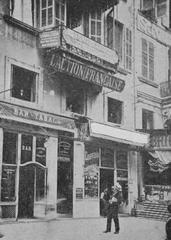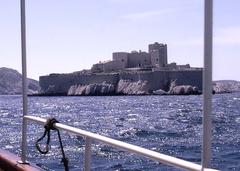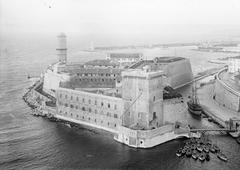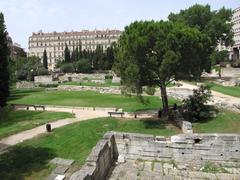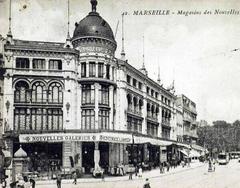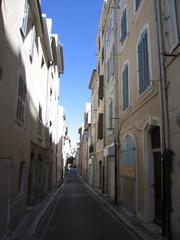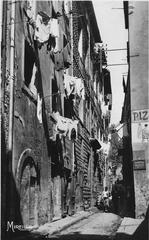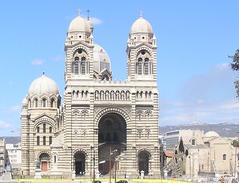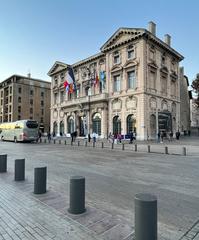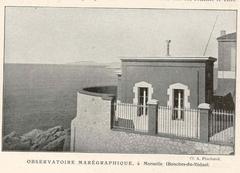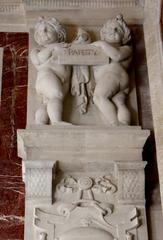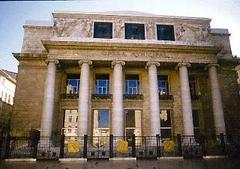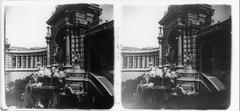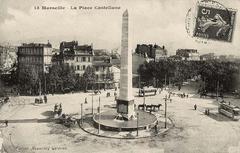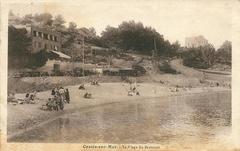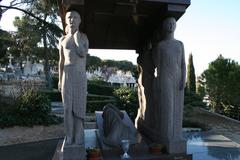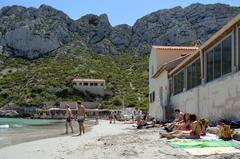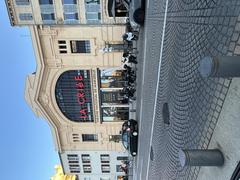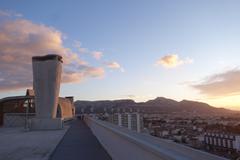
Saint-Henri Marseille Visiting Hours, Tickets, and Historical Sites Guide
Date: 04/07/2025
Introduction to Saint-Henri in Marseille
Saint-Henri, located in Marseille’s 16th arrondissement, is a fascinating destination for travelers interested in discovering an authentic neighborhood brimming with history, cultural diversity, and a proud industrial past. Unlike more frequented tourist attractions, Saint-Henri offers a unique perspective on the city’s evolution—from a rural enclave with prolific vineyards to a dynamic working-class hub shaped by the booming tile and brick industries of the 19th and 20th centuries. This transformation, spurred by local clay deposits and waves of immigration, is still reflected in the area’s distinctive architecture and vibrant community life.
Notable landmarks, such as the Saint-Henri Monument—which honors the historic tile factories—and the Saint-Henri Church, serve as focal points for visitors. Practical details regarding visiting hours, accessibility, and transportation make it easy to plan your trip, whether you’re arriving by public transport or car. In addition, Saint-Henri’s proximity to Marseille’s port and natural attractions like the Bassin de Séon and Massif de l’Estaque hills provides further opportunities for exploration.
This guide delves into Saint-Henri’s origins, industrial heritage, and contemporary character, offering travel tips, local insights, and recommendations for nearby sites. Discover a lesser-known side of Marseille that embodies the city’s resilient spirit and multicultural mosaic. For detailed maps, guided tours, and up-to-date information, travelers are encouraged to use resources like the Audiala app and official tourism platforms.
Explore the industrial legacy and cultural vibrancy of Saint-Henri—Marseille’s hidden gem. (Saint-Henri Wikipedia, Marseille Tourism Official Site, Nomadic Matt’s Marseille Guide)
Contents Overview
- Welcome to Saint-Henri: Exploring Marseille’s Hidden Historical Site
- Origins and Early Development
- Agricultural Era and Transformation
- Industrialization and the Tile Industry
- Integration into Marseille and Urban Evolution
- Cultural Significance and Heritage
- Visiting Saint-Henri: Practical Information
- Visiting Hours & Access
- How to Get There
- Accessibility
- Nearby Attractions
- Guided Tours & Events
- Photography Tips
- Saint-Henri Monument: Visitor Information and Historical Significance
- Saint-Henri Church: History, Practical Information, and Local Culture
- Visiting Saint-Henri: Practical Information, Travel Tips, and Local Insights
- Getting to and Around Saint-Henri
- Accommodation Options
- Essential Visitor Services
- Local Amenities and Facilities
- Practical Tips for Visitors
- Cultural Etiquette and Local Customs
- Events and Community Activities
- FAQ
- Emergency Contacts
- Sustainable Tourism
- Useful Links
- Summary and Visitor Recommendations
- Sources and Further Reading
Discover Saint-Henri, Marseille: A Historical Gem with Visitor Tips, Hours & More
Welcome to Saint-Henri: Exploring Marseille’s Hidden Historical Site
Situated in the 16th arrondissement, Saint-Henri presents a rich tapestry of history, culture, and landscapes shaped by centuries of agricultural and industrial activity. This guide provides everything you need to know about visiting Saint-Henri—from its origins and heritage to practical tips for your trip.
Origins and Early Development
Originally known as Séon Saint-Henri, the area was a rural enclave in the Bassin de Séon (Saint-Henri Wikipedia). In the 16th century, the Saumati family owned the land, leasing it to tenant farmers who cultivated vineyards and smallholdings. The village’s name comes from a central chapel, and by 1745, Saint-Henri had gained ecclesiastical independence, marking its distinct community identity.
Agricultural Era and Transformation
Saint-Henri flourished as a viticultural center, producing acclaimed white wines thanks to its Mediterranean climate and clay-rich soils. This prosperity ended in 1863 when the phylloxera epidemic devastated local vineyards, pushing the community to seek new economic paths.
Industrialization and the Tile Industry
The late 19th and early 20th centuries marked Saint-Henri’s transformation into an industrial hub. Abundant clay deposits fueled the growth of tile and brick factories, reshaping the landscape and attracting a diverse workforce (Saint-Henri Wikipedia, Marseille Tourism Official Site). Infrastructure improvements, including the departmental road 568 and the Paris-Marseille railway, integrated Saint-Henri into the city’s economic network.
Integration into Marseille and Urban Evolution
After the French Revolution, Saint-Henri’s lands became part of Marseille, evolving into a working-class district in the “quartiers nord.” The decline of industry in the late 20th century brought economic challenges; today, Saint-Henri is primarily residential, with around 1,900 inhabitants and a poverty rate near 39% (Saint-Henri Wikipedia). Revitalization is ongoing in areas like cité Rabelais and résidence des Muriers.
Cultural Significance and Heritage
Saint-Henri mirrors Marseille’s broader story of migration and economic change (Nomadic Matt’s Marseille Guide). The legacy of the tile industry is evident in the architecture and urban layout, while the parish church stands as a focal point for community life and local festivals.
Visiting Saint-Henri: Practical Information
Visiting Hours & Access
Saint-Henri is open year-round, with no formal ticketing for visiting the neighborhood or the parish church. Spring and early autumn are ideal for walking tours and photography.
How to Get There
- Public Transport: Marseille’s bus lines serve the 16th arrondissement; the nearest metro stations are Bougainville and La Rose, with connecting buses to Saint-Henri.
- By Car: Use departmental road 568 (Route du Littoral). Parking is limited, especially during peak times.
Accessibility
Main streets and the parish church are generally accessible, though some terrain shaped by clay extraction may be challenging for those with limited mobility.
Nearby Attractions
- Bassin de Séon: Coastal plains and natural surroundings.
- Marseille History Museum: Dive deeper into city heritage (Marseille History Museum).
- Port of Marseille: Explore the bustling harbor area.
Guided Tours & Events
While there are no dedicated tours for Saint-Henri, some Marseille city tours include stops in the northern districts. Local festivals at the parish church provide cultural insight—check the Marseille Tourism Official Site for event calendars.
Photography Tips
Capture industrial remnants, clay pits, and colorful workers’ housing during golden hour. The parish church’s architecture is a highlight.
Saint-Henri Monument in Marseille: Visitor Information and Historical Significance
Historical Significance
The Saint-Henri Monument honors the area’s pivotal tile and brick factories, such as Tuilerie Saint-Henri, Sacoman, Arnaud, Rolland, and Tamisier. Built in the early 20th century, it symbolizes the resilience and multicultural fabric of the neighborhood, whose fortunes rose with Marseille’s maritime and industrial expansion.
Visiting Hours
- Daily: 9:00 AM – 6:00 PM
- Last admission: 5:30 PM
- Note: Check the Marseille Tourism Official Site for holiday updates.
Tickets and Admission
Admission is free. Guided tours are available on weekends and public holidays for a nominal fee (advance booking recommended).
Getting There
- Bus: Local lines stop near Chemin de l’Estaque and Chemin de Saint-Henri.
- Train: L’Estaque station is a 10-minute walk from the monument.
- Car: Parking available nearby via main roads.
Nearby Attractions
- Massif de l’Estaque: Hiking trails with panoramic views.
- Industrial port area: Explore Marseille’s maritime legacy.
- Local cafés and shops: Experience the neighborhood’s social life.
Amenities and Accessibility
- Public restrooms and benches.
- Wheelchair-accessible paths.
- Informational signage in French and English.
Special Events and Guided Tours
Annual heritage days and guided walking tours focus on architecture and social history. For dates, visit the Marseille Tourism Official Site.
Photography Tips
Best lighting is during early morning or late afternoon. The monument’s brickwork and views of the Mediterranean are especially photogenic.
Discovering Saint-Henri Church: A Historical and Cultural Landmark in Marseille
History
Built in the early 20th century, the Saint-Henri Church reflects the architectural styles typical of Marseille’s religious buildings and serves as a spiritual and social anchor for the neighborhood.
Visiting Hours and Ticket Information
- Monday–Saturday: 9:00 AM – 6:00 PM
- Sunday: 9:00 AM – 1:00 PM
- Admission: Free
- Guided Tours: Weekends at 11:00 AM and 3:00 PM (advance booking via Marseille Tourism Official Site or at the church).
Accessibility and Facilities
- Wheelchair-accessible entrance and restrooms.
- Audio guides in French, English, and Italian.
- Photography allowed except during services; modest dress is recommended.
Location and Getting There
- Address: 12 Rue Saint-Henri
- Public Transport: Buses 19 and 82 stop nearby.
- Parking: Limited street and public garage options.
Nearby Attractions
- Saint-Henri’s street art, markets, and the Corniche for coastal walks.
- Old Port and Panier district (short bus ride).
Local Traditions and Festivals
The Feast of Saint Henry in July features processions and communal meals. The church also participates in citywide events like Fête de la Musique and Christmas celebrations.
Practical Tips
- Visit in spring or autumn for the best weather.
- Dress modestly for church visits.
- Reserve guided tours in advance, especially during festivals.
Visual Highlights
Don’t miss the stained glass windows and courtyard views. Nearby street murals offer vibrant photography opportunities.
Visiting Saint-Henri, Marseille: Practical Information, Travel Tips, and Local Insights
Getting to and Around Saint-Henri
- Air: Marseille Provence Airport (MRS) is 27 km from the city center. Shuttle buses connect to Gare Saint-Charles (Lonely Planet).
- Train: TGV and TER trains serve Marseille.
- Public Transport: RTM’s two metro lines, three tram lines, and extensive buses. Le Vélo bike-sharing is also available (Destination Abroad).
- Bus: Line 36 directly connects to Saint-Henri from central Marseille.
Accommodation Options
While Saint-Henri itself has limited lodging, nearby L’Estaque, Vieux-Port, and central Marseille offer a range of hotels, guesthouses, and rentals (France.fr).
Dining and Shopping
Traditional bakeries, cafés, and small restaurants abound. L’Estaque is renowned for seafood and panisses (France.fr). Local markets and shops showcase Saint-Henri’s heritage.
Local Life and Markets
While Saint-Henri lacks a major market, nearby Marché de L’Estaque is lively. Social clubs and shops reflect the neighborhood’s working-class roots.
Practical Tips
- Best Time: April–June and September–October for mild weather.
- Language: French is primary; English is less common in Saint-Henri.
- Currency: Euro (€); cards widely accepted.
- Connectivity: Free Wi-Fi in public areas; good mobile coverage.
- Safety: Standard urban precautions advised (Lonely Planet).
Cultural Etiquette
Modest dress is recommended for religious events. Always ask before photographing people. Respect local customs, especially during community gatherings.
Events and Community Activities
Saint-Henri hosts local festivals and sports events. For current event listings, consult the Marseille Tourist Office.
Emergency Contacts
- Emergency (Police, Fire, Medical): 112
- Tourist Police: +33 (0)4 91 15 20 13
- Marseille Tourist Office: +33 (0)4 91 13 89 00
Sustainable and Responsible Tourism
Use public transport, refill water bottles (city tap water is safe), and respect local customs (Lonely Planet).
Useful Links
Summary and Visitor Recommendations
Saint-Henri encapsulates the story of Marseille’s transformation—from rural vineyards to a bustling industrial district and now a multicultural residential area. The neighborhood’s landmarks, like the Saint-Henri Monument and parish church, are tangible reminders of its economic and social evolution. Visitors can enjoy Saint-Henri’s unique ambiance, industrial relics, and lively festivals without entrance fees or restrictive hours. Its proximity to Marseille’s port, natural landscapes, and other attractions enriches the experience.
For those seeking an off-the-beaten-path encounter with Marseille’s history and culture, Saint-Henri is an essential stop. Enhance your visit with guided tours during events, immerse yourself in community celebrations, and capture the evocative architecture through your lens.
Plan your journey with the Audiala app and official tourism resources to ensure a memorable and authentic Marseille adventure. (Marseille Tourism Official Site, Marseille History Museum, France.fr)
Sources and Further Reading
- Saint-Henri Wikipedia
- Marseille Tourism Official Site
- Nomadic Matt’s Marseille Guide
- Marseille Heritage Official Website
- Marseille History Museum
- France.fr
- EPS-HEP 2025 Visitor Info
- Lonely Planet
- Destination Abroad

